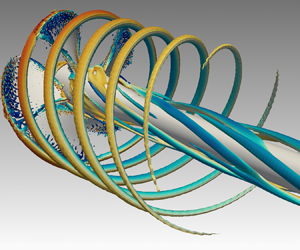Article contents
Scaling properties of the Ffowcs-Williams and Hawkings equation for complex acoustic source close to a free surface
Published online by Cambridge University Press: 21 September 2021
Abstract

We perform a scaling analysis of the terms composing the Ffowcs-Williams and Hawkings (FWH) equation, which rules the propagation of noise generated by a rigid body in motion. Our analysis extends the seminal work of Lighthill (Proc. R. Soc. Lond. A, vol. 211, 1952, pp. 564–587) and the dimensional analysis of classical sources (monopole, dipole and quadrupole) considering all the FWH integral terms. Scaling properties are analysed in light of perfect/imperfect similarity when laboratory-scale data are used for full-scale predictions. As a test case we consider a hydrodynamic example, namely a laboratory-scale ship propeller. The data, obtained numerically in a previous study, were post-processed according to the scaling analysis presented herein. We properly scale the speed of sound to obtain perfect similarity and quantify the error with respect to the imperfect scaling. Imperfect similarity introduces errors in the acoustic response related both to the linear terms and to the nonlinear terms, the latter of great importance when the wake is characterized by robust and organized vorticity. Successively, we analyse the effect of a free surface, often present in hydrodynamic applications. We apply the method of images to the FWH equation. The free surface may generate a frequency-dependent constructive/destructive interference. The analysis of an archetypal acoustic field (monopole) provides robust explanation of these interference effects. Finally, we find that imperfect similarity and the absence of a free surface may introduce errors when model-scale data are used to obtain the full-scale acoustic pressure. The error is small for microphones placed in the near field and becomes relevant in the far field because of the nonlinear terms.
JFM classification
- Type
- JFM Papers
- Information
- Copyright
- © The Author(s), 2021. Published by Cambridge University Press
References
REFERENCES
- 21
- Cited by





